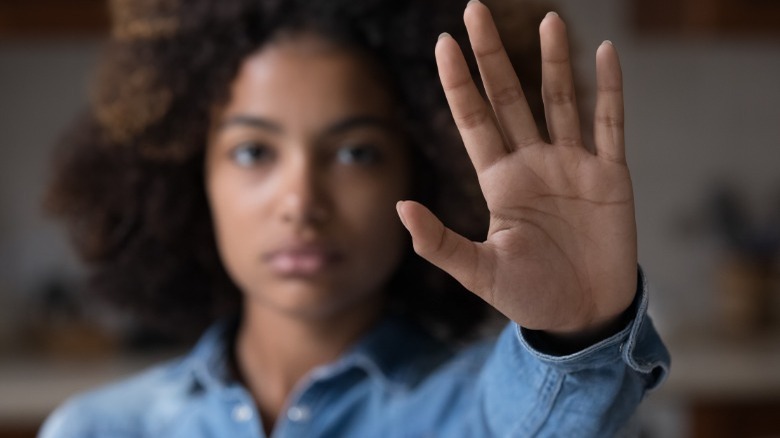The Healthiest Way To React When Your Emotions Have Been Triggered
Does this situation sound familiar? You're hanging out with friends, having a great day, when someone says something that sends you into a panic. It was most likely an offhand comment, but it made the hairs on the back of your neck stand up. This is an emotional trigger, an automatic reaction to convey an emotion such as anger, sadness, or anxiousness (per Workplace Strategies for Mental Health). Essentially, triggers can be anything — people, places, words, and even colors. They're usually rooted in past experiences.
For example, you may have a history of abusive relationships, and you happen across a video online discussing the topic. This can evoke a string of intense emotions, bringing up old feelings you had when you were in the relationship. You might feel angry about what happened to you and not know how to handle it. You may lash out at others or become overwhelmed with intrusive thoughts. It's understandable, but it can be frustrating when you want to move past that point in your life. Fortunately, there is a healthy way to react when your emotions have been triggered.
If you or someone you know is dealing with domestic abuse, you can call the National Domestic Violence Hotline at 1−800−799−7233. You can also find more information, resources, and support at their website.
The Stop, Drop, and Roll method
No matter your reaction to a trigger, remember your feelings are completely valid, even if your reaction may seem irrational to you or others. In a situation where your emotions have been triggered, your amygdala (the part of the brain responsible for processing fearful stimuli, per PNAS) goes into overdrive, trying to protect you from the threat or danger you're faced with. This makes it difficult to think clearly and rationally, and that is where the first step in the "Stop, Drop, and Roll" method comes into play.
When using this method, the first thing to remember is to STOP: S (stop), T (take a breath), O (observe your physical sensations, thoughts, and feelings), and P (proceed with better awareness). When you've completed this step, your amygdala should calm down, sending a message to your brain that you aren't in danger, just triggered. This way, you can think more clearly and deduce whether or not danger actually lies ahead.
How to Drop and Roll
After you've finished the first step of the "Stop, Drop, and Roll" method, it's time to move on to the second step, drop. This refers to the act of "dropping" into your experience to better understand how your body is affected by the trigger. During the drop phase, ask yourself questions like, What parts of my body are affected when my emotions are triggered? What is making me aware that I'm angry or anxious? How does my body shift once I no longer feel I'm in danger?
For the final step, it's important for you to "roll" with your feelings, whether you're overcome with anxiety, anger, or sadness. A lot of the time, we tend to suppress our emotions as a form of self-protection, The Arbor explains. In other words, if we don't let ourselves feel those intense emotions, they can't hurt us. It's an unhealthy way to deal with triggers, which is why "rolling" is so important. You're allowing yourself to ask those emotions what they need to heal. For example, this could mean going to therapy, meditating, or practicing self-care.


